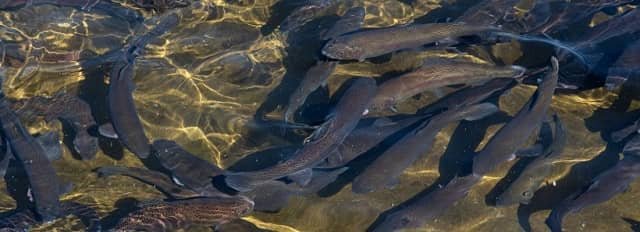
The final stages of production are critical in the fish farming industry, impacting both animal welfare and the quality of the final product. These moments not only pose a risk to fish welfare but can also cause significant economic harm to fish farmers, as the slaughter process can affect meat quality and the appearance of the final product.
Traditionally, fish slaughter has employed asphyxiation methods such as ice water or exposure to air. However, humane slaughter practices require stunning to render fish unconscious before death.
Scientists from the Fish Etho Group Association, Centro de Ciências do Mar, Fondazione Edmund Mach, Escola Superior Agrária de Santarém, and Università degli Studi di Firenze evaluated and compared the effectiveness and welfare effects of four stunning methods on rainbow trout (O. mykiss): cold shock by rapid cooling as a novel method, where fish were immersed in liquid water at -8°C, asphyxiation (currently used method), electric stunning, and MS-222 anesthesia.
Methodology
The study involved 176 rainbow trout and analyzed their behavior, physiology, cortisol levels, and brain proteomic signatures. Quality parameters of the fillet, such as shelf life, rigor mortis, water content, color, pH, and ATP degradation, were also evaluated.
This study assessed and compared the effectiveness and welfare effects of four stunning methods in rainbow trout:
- Cold shock: Immersion in liquid water at -8°C (novel method)
- Asphyxiation: Current industry practice
- Electric stunning: Electric shock to induce unconsciousness.
- MS-222 anesthesia: Chemical induction of unconsciousness.
Key Results
The study results provide valuable insights into the comparative effectiveness of trout stunning methods. Here is a brief description of the results for each method:
- MS-222 Anesthesia: Effectively induces unconsciousness with minimal stress, resulting in the best fillet quality among all methods.
- Electric Stunning: Effective and irreversible method, with strong heartbeats and acceptable variations in cortisol levels and quality indicators.
- Asphyxiation: Indicates poor welfare with prolonged consciousness, high cortisol levels, and poor meat quality.
- Rapid Cooling: Demonstrates extreme stress (mucus release, bleeding, no loss of consciousness), low ATP content, and the worst quality indicators.
“Electric stunning emerged as a viable and humane method for rainbow trout stunning on a commercial scale. However, the novel rapid cooling stunning method presented limitations, as it caused abnormal fish behavior,” reported the researchers.
Significance for Fish Farmers
The study results confirm that fish welfare during slaughter and fillet quality parameters are closely aligned. “Fish experiencing lower stress levels and exhibiting more humane responses showed better fillet quality characteristics,” the researchers report.
In this regard, the following recommendations can be drawn for fish farmers:
Stay Always Informed
Join our communities to instantly receive the most important news, reports, and analysis from the aquaculture industry.
- Electric stunning emerges as a promising humane method for rainbow trout slaughter.
- Rapid cooling is not a viable alternative to asphyxiation due to its negative impact on both welfare and meat quality.
- Brain proteomic analysis provides valuable information about fish welfare at the time of slaughter, offering potential biomarkers for future research.
Conclusion
This study highlights the crucial role of humane slaughter practices in aquaculture. By prioritizing methods like MS-222 anesthesia and electric stunning, the industry can ensure animal welfare and maintain high-quality meat products.
“These findings serve as a reminder of the ethical and economic importance of welfare considerations in the aquaculture industry, promoting sustainable and responsible practices that ultimately benefit both the industry and consumers,” conclude the study authors.
Future research can further explore these methods and use proteomic analyses to refine fish welfare assessment and enhance ethical practices in aquaculture.
The study was funded by the Provincia Autonoma di Trento and Foundation for Science and Technology (FCT).
Contact
Maria J. Cabrera-Álvarez
Fish Etho Group Association, Olhão, Portugal
Email: maria@fishethogroup.net
Reference (open access)
João L. Saraiva, Filippo Faccenda, María J. Cabrera-Álvarez, Michele Povinelli, Peter C. Hubbard, Marco Cerqueira, Ana Paula Farinha, Giulia Secci, Maria Vittoria Tignani, Lina F. Pulido Rodriguez, Giuliana Parisi. 2023. Welfare of rainbow trout at slaughter: Integrating behavioural, physiological, proteomic and quality indicators and testing a novel fast-chill stunning method, Aquaculture, 2023, 740443, ISSN 0044-8486, https://doi.org/10.1016/j.aquaculture.2023.740443.
Editor at the digital magazine AquaHoy. He holds a degree in Aquaculture Biology from the National University of Santa (UNS) and a Master’s degree in Science and Innovation Management from the Polytechnic University of Valencia, with postgraduate diplomas in Business Innovation and Innovation Management. He possesses extensive experience in the aquaculture and fisheries sector, having led the Fisheries Innovation Unit of the National Program for Innovation in Fisheries and Aquaculture (PNIPA). He has served as a senior consultant in technology watch, an innovation project formulator and advisor, and a lecturer at UNS. He is a member of the Peruvian College of Biologists and was recognized by the World Aquaculture Society (WAS) in 2016 for his contribution to aquaculture.




